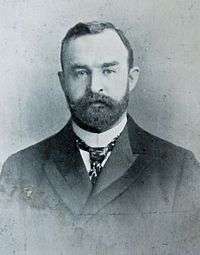John Alexander Brodie
| John Alexander Brodie | |
|---|---|
 | |
| Born | 1858 |
| Died | 1934 |
| Nationality | British |
|
Engineering career | |
| Discipline | Civil |
| Institutions |
Institution of Civil Engineers (president), |
John Alexander Brodie (1858 – 1934) was a British civil engineer.[1]
Brodie began his professional career in 1875 working in the Mersey Docks and Harbour Board engineering department under Chief Engineer George Fosbery Lyster, following this he set up a private consultancy and spent some time working in Spain.[1] In 1889 he invented the goal net for use in football matches and he said that this was the invention of which he was the most proud.[2][3] Brodie returned to Liverpool in 1898 as the city engineer suggesting several improvements for the town such as the UK's first ring road, electric trams and the East Lancashire Road, the UK's first intercity highway.[1]
He was at the fore front of pre-fabricated housing technology promoting the use of pre-cast reinforced concrete slabs as a means of building houses quickly and cheaply, he presented an example of this technique to the Cheap Cottages Exhibition at Letchworth where many examples of this kind of building can be found to this day. The design attracted attention from across the world and he is known to have influenced Grosvenor Atterbury who used a similar technique to build the houses at Forest Hills Gardens.[1]
Brodie was also interested in town planning and this was recognised in 1912 when he was asked to help select the site of and plan New Delhi. He visited India twice for this purpose and in 1931 was invited to the official opening ceremony by the Viceroy owing to the high regard that Edwin Lutyens, the chief planner had for him.[1]

He served as president of the Institution of Civil Engineers between 1920 and 1921,[4] becoming the first local authority engineer to receive the accolade.[1] He was also an Associate Professor of Engineering at Liverpool University and vice-president of the Liverpool Self-Propelled Traffic Association which would later become a constituent of the Royal Automobile Club.[1]
But Brodie's greatest engineering achievement was undoubtedly the Mersey Tunnel completed in 1934 following nine years in the making. At the time of its construction it was the world's longest underwater road tunnel, a title it held for 24 years, and remains to this day the UK's largest municipal engineering project.
After his death in 1934 Liverpool City Council named Brodie Avenue in his honour.[5] Brodie's former Liverpool home, 28 Ullet Road, where he lived from 1858 to 1934 is commemorated with an English Heritage blue plaque.[6]
References
- 1 2 3 4 5 6 7 Mersey Gateway biography
- ↑ Goalposts and Goalnets – Insider – Football Culture – British Council Japan at the Wayback Machine (archived March 23, 2006)
- ↑ Herbert, Ian (2000-07-07). "Blue plaque for man who invented football goal net". The Independent. London. Retrieved 2010-05-06.
- ↑ Watson, Garth (1988). The Civils. London: Thomas Telford Ltd. p. 252. ISBN 0-7277-0392-7.
- ↑ Liverpool Pictoral road names list
- ↑ "Room 4 28 Ullet Road, Sefton Park, Liverpool L8". Property Search. Zoopla.
External links
- Obituary Institution of Civil Engineers, 1935 (BROKEN)
| Professional and academic associations | ||
|---|---|---|
| Preceded by John Griffith |
President of the Institution of Civil Engineers November 1920 – November 1921 |
Succeeded by William Barton Worthington |